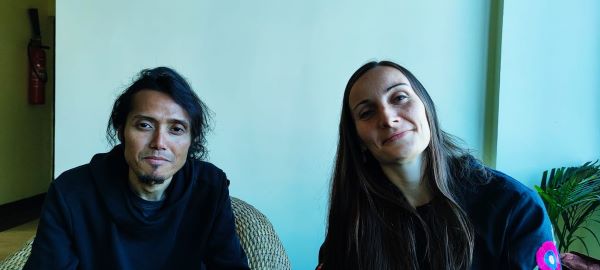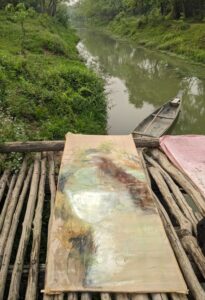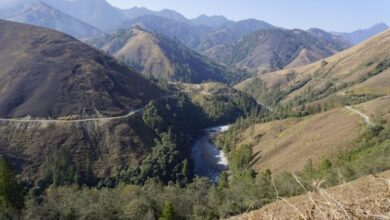‘My work is about preserving images of mutuality & coexistence found in nature’
Slovak artist explores NE through plein art, workshops & fusion project in SWKH

Slovak artist Jana Bednarova and Assamese musician Alakesh Dutta wanted the arts and cultures of their respective countries to connect and this drove the formation of Picasso Pupils, an art society.
Formed in 2015, the society has organised numerous en plein art workshops in the North East and school projects, inviting artists worldwide, including Slovakia. The region’s natural abundance, particularly Meghalaya, and Dutta’s roots in Assam are the reasons the talented couple chose the North East as their creative base. Picasso Pupils also has a chapter in Slovakia.
“We started with small workshops in schools. In Shillong, only Shillong Public School showed interest in a creative ideas workshop for their children. The principal, Aaron Warjri, is one of the few enlightened people we had the opportunity to meet here. He was truly interested in innovation and progress. The drive for growth inspires our art society, cultural exchange and innovative ideas of various people we meet in India and abroad,” Bednarova, 38, told Meghalaya Monitor.

Bednarova moved to Assam after completing her master’s in painting from MSU Baroda. It was here that she met her husband and creative partner. Though Bednarova has a studio in Shillong, her focus is on plein art. Hence, she often travels away from the city to work amid nature and in natural light.
Her works have inspired the Pine Home project that Picasso Pupils is implementing along with Saitsnat Society, an organisation in South West Khasi Hills. Under this project, the artists are introducing contemporary technologies in architecture using locally available materials.
Dutta is equally closely associated with Picasso Pupils and its workshops as the main organiser. His roots in the North East have helped Bednarova explore the region and exchange ideas with locals.
Meghalaya Monitor spoke to the artist to learn more about the workshops, the art projects and plans to expand Picasso Pupils.
En Plein Air painting has been practised among artists for decades and is popular today. What is it about plein air painting that artists are practising even today?
The plein-air approach to the artwork was popularised by the European painters of France living in the 19th century as a contrast with studio painting or academic rules of that time, that might predetermine the look. Today, the plein air serves different artists with different concepts in their art practices.
For me, it started as my personal need to get close to nature, which I was fascinated by in North East India.
My first expeditions to the deep jungles were overwhelming as I got exposed to the atmosphere of harmony and peace. Through my artworks painted directly in the plain air of a rainforest, I attempt to understand the vastness of nature, her ability to grow in very difficult terrain and survive unfavourable times. Now, my expeditions to the wild jungles are an inspiration for the orchid project that I am working on currently and other concepts in my art practice and everyday life.
Would you say you have pioneered the practice in the North East?
The plein air is known to have been pioneered by John Constable in Britain as a reaction to idealised landscape paintings in his time. And maybe some colonisers brought their painters to capture the places of the North East. But in the case of this art practice in the North East, there is poor study material about it. So, I do not have any idea by whom it was pioneered in this part of India. North East, Especially Assam thanks to Sankardeva is known for pat painting, which was presented as a part of theatre backgrounds from the 16th century.
This scholar, who has a great contribution to preserving the various tribal art forms of North East India, is known also for preserving the Hengul Haital painting with traditional pigments which were used in the Ahom kingdom for the illustration of manuscripts. Those pigments I have studied more deeply and currently I am using them in my plein air paintings. I choose to replace the oil and acrylic paints with these naturally sourced pigments, which I apply on locally handwoven silk material for my paintings. As my artworks talk about preserving the untouched jungles and disheartening stories of untouched nature, I try not to leave a carbon footprint after my painting expeditions and reduce the industrially manufactured acrylic paints.

Which places have you captured through your plein-air art projects?
I have been staying on and off in Meghalaya for nearly 10 years and during this time I have visited many places. I have concluded my first art project in a solo show called ‘Root Bridges’ displayed at Cin Cin Gallery in Bratislava, Slovakia. The exhibition showcased the root architecture and the endless waterfalls and talked about the connection of a person to nature, which is borderless and triggers the feeling of peace at home.
Through a scholarship from the Slovak Art Foundation, I had the opportunity to visit Kaziranga National Park in Assam and Dzukou Valley in Nagaland. In Kaziranga, I painted with special permission near anti-poachers’ camps and learned about the ecosystem of the jungle, which can offer a lot of inspiration to human society. In the jungle, every animal and every living being has space to fulfil a life. Every being lives in some kind of symbiosis and respects each other’s living space.
In Meghalaya, how many schools have you collaborated with for art workshops? Which are the schools? How many artists from abroad were involved?
In 2016, we established an art residency called the Artists Point which has been inviting artists from abroad to Meghalaya to stay for a month, get inspired by the place and at the same time collaborate and hold workshops for school children and art enthusiasts. I cannot count, it has been many schools and many youths we have worked with mostly in rural areas, where children and youth have the rare chance to experience creative workshops and meet enthusiasts and innovative resource persons from abroad. Besides artists from Slovakia, we were hosting participating professionals from Austria, Belgium, Bangladesh, the Czech Republic, Denmark, Hungary, Japan, Nepal, Spain, Ukraine and the UK.
Tell us something about the Pine Home project.
Pine home is closely related to the concept of my art practice as it focuses on introducing locally available 
Photo by Picasso Pupilsmaterials and preserving nature.
Pine Home is a complex project that started in 2018 with research and now it is two years it has been implemented by Picasso Pupils and Saitsnat Society in South West Khasi Hills. It aims to introduce contemporary technologies in architecture used in first-world countries and implement them in rural places of Meghalaya by using locally available materials.
The project is conducted by international architects from Slovakia, Europe, who have designed holistically the architecture units, which will serve as a hub of culture and tourism and fulfil the energetic standards of the first-class architectural structure explicable locally on a large scale.
The project focuses on saving energy and minimising the pollution. Pine Home will try to introduce growth for the rural community without compromising on carbon footprints. It will preserve the cultural heritage of the place through innovative and captivating activities. The outcome of the project is a contemporary learning centre for the ecological practices in architecture as well as an example of the tourism practice with the solution for energy management and pollution control which has been widely neglected in South Asia.
There are many things to discuss about the background of the project, the technologies implemented and the impact of the outcome, which we would be happy to publicise after the developing stage is completed.
How often do you organise workshops? Are the workshops theme/idea-based?
We try to organize workshops through the Artists Point art residency project every year, we involve mostly school children in rural areas and prepare creative innovative workshops not only to teach art techniques but also to show creative teaching tricks for explaining the topic of Mathematics, Geography and science. The Pine Home project includes wide workshops for local people to learn new building techniques and technologies to save natural resources. At the same time, we are involving university students in the implementation of architectural practices in first-world countries.
Our workshops are project-based and focus on activities for children and youths.
Slovak art and artists in the last century were greatly inspired by the political atmosphere in the country. Is the present century still seeing an upsurge of such creativity?
Well, yes in the last century, Slovakia, like the rest of Eastern Europe, was under the autocratic rule of the Soviet Union. There was no freedom of democracy and the same went for art. People were living in a totalitarian regime. There was an official cultural doctrine that mandated an idealised representation of life under socialism in music, literature, film and the visual arts. The regime established strict standardisation in cultural institutions, magazines and schools and limited freedom of experimental art and activism.
After the 60s when hope was placed in Alexander Dubček’s democratisation process, the centralised establishment showed its power in 1968, when army troops invaded the territory of Czechoslovakia. The normalization process began again as well as the establishment of new propaganda requirements in artistic creation. Conceptual art, or the art practices known as the movement Fluxus has moved from the urban space to the non-institutional space of nature and landscape and the privacy of apartments and art studios. The symbolic event for this transformation of the art scene was the first open studio of Rudolf Sikora in November 1970, where three generations of progressive artists met in his home studio in Bratislava. The underground art scene of artists who were not interested in portraying happy people working in the fields or were rebelling against the system used to meet and display the works for each other only in small groups privately.
After the fall of the Berlin Wall, the various practices of conceptual art including activism in art became a legitimate art medium and previously restricted and prohibited artists of Slovakia became wildly exhibiting and some of them famous in entire European platforms like Július Koller, Stano Filko, Jana Želibská, Milan Adamčiak etc.
After the Velvet Revolution in 1989 and the establishment of Slovakia as an independent democratic country in 1993, the tradition of Conceptual art continues till now as a respected art practice which communicates not only issues of artistic matter but also engages in public and comment on social and political issues freely.
In my art, I am not choosing an activist approach though my creative art practice is deeply driven by the disturbing knowledge about all the environmental issues in the world. Then commenting on global politics, I am focusing on research about the background psychology of humans… There is a disturbing knowledge about us humans who historically tend to compete, colonize and conquer.
I am observing that we are closing ourselves into the urban spaces and becoming detached from the natural ecosystem. The idea behind creating my artworks is to document the compositions of the wild jungle and keep a message about the presence of the places where each living being has the right to fulfil its life and where the entire ecosystem grows in symbiosis without parasitising each other. My current work thinks about preserving those images of mutuality and coexistence.
Each state in the NE, including Meghalaya, has its inspiration for artists and art. Do you find any similarity with your country of origin?
The entire North East is very exotic and fascinating. In Slovakia, we have five national parks, so you can see the wild nature, however, the tropical rainforests are just something else. Thanks to my friends here in Meghalaya I become closer to the people and through my husband, I have a family in Assam. So, I don’t feel foreign here anymore.
I observed that the people of Meghalaya, especially in rural areas, have some similarities to the people in Slovakia. I am from the hilly side and people from the hills are easily scared of what is behind the hill. At the same time, the humour and kindness of people who become your friends are very strong.
~ Team Meghalaya Monitor





